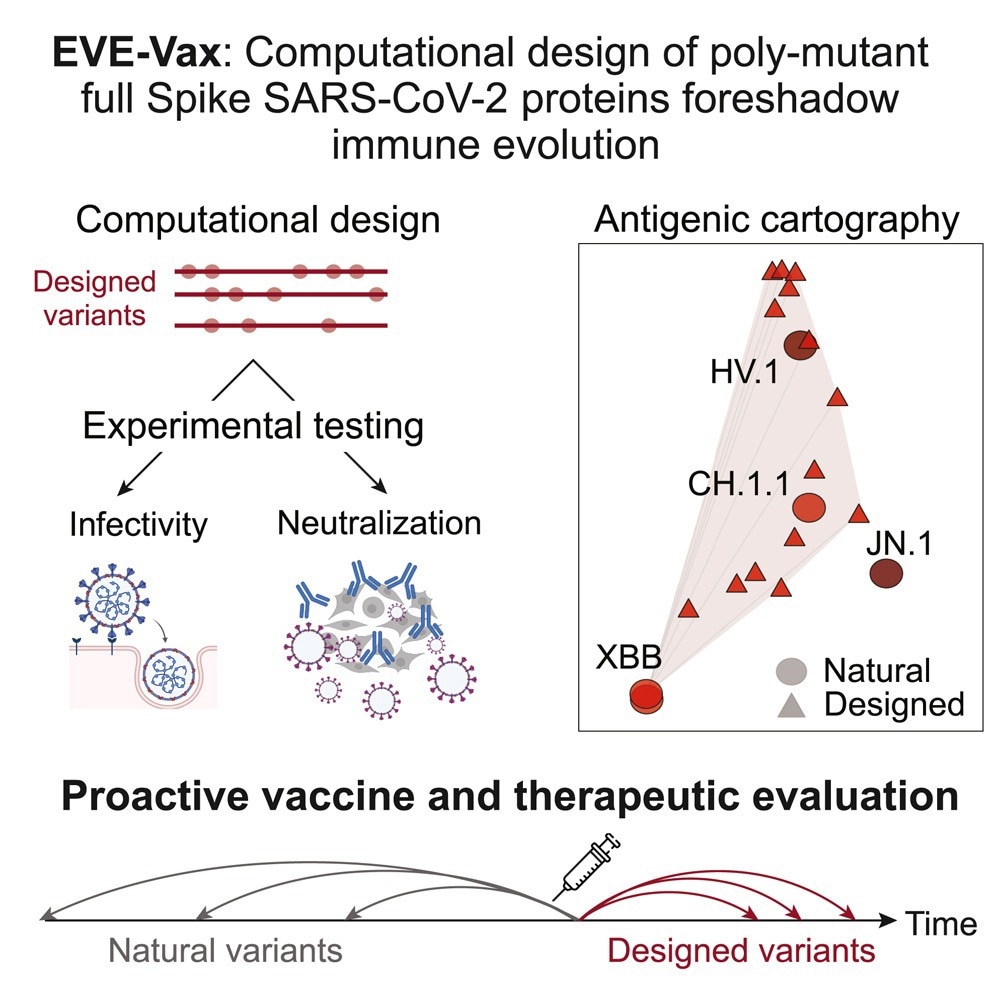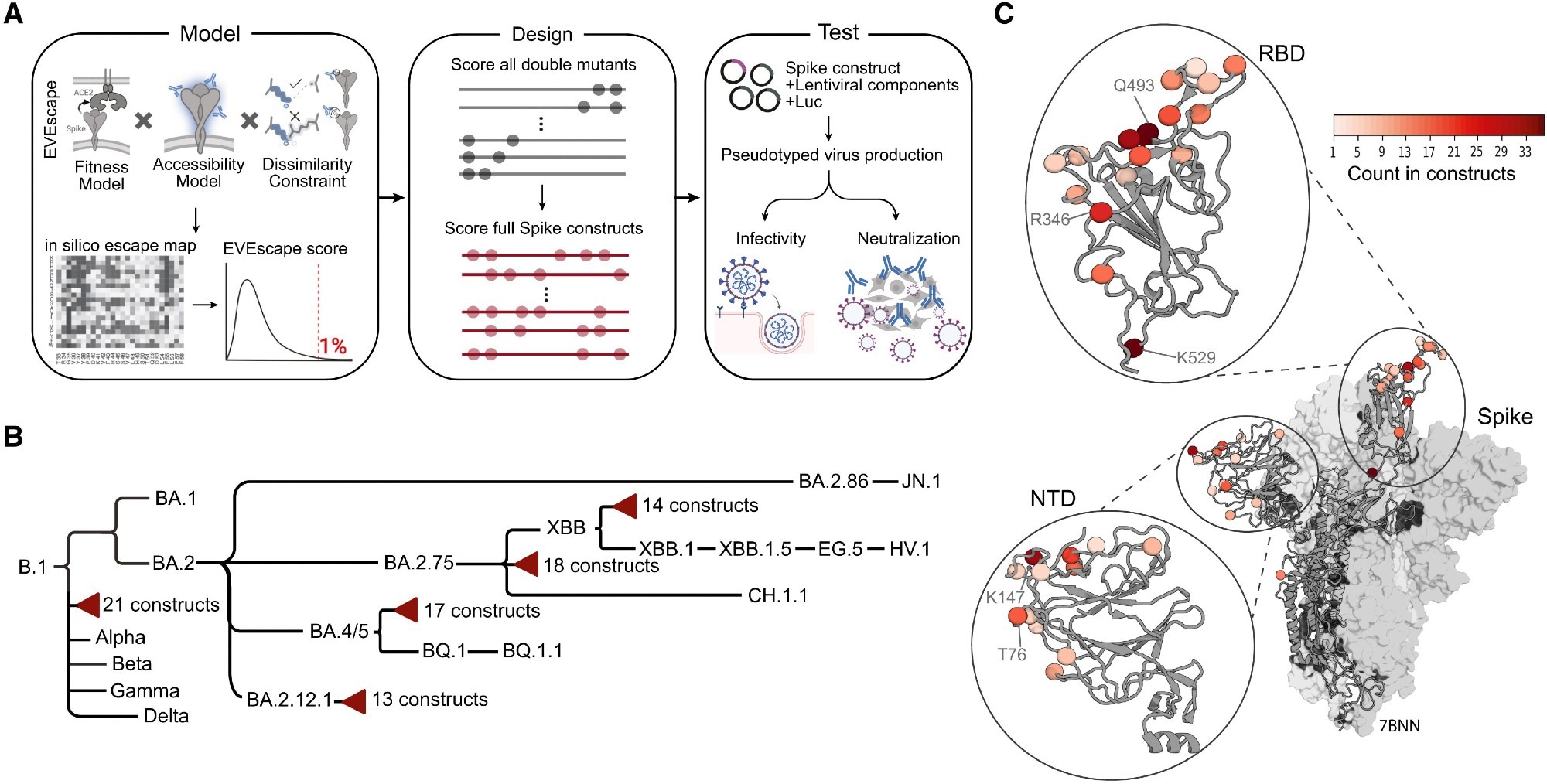Researchers have developed EVE-Vax, a computational design tool that creates synthetic SARS-CoV-2 spike proteins mimicking future immune-evading variants. These designed proteins enable early assessment of vaccine efficacy before such variants naturally emerge.
 Study: Computationally designed proteins mimic antibody immune evasion in viral evolution. Image Credit: TimeStopper69 / Shutterstock
Study: Computationally designed proteins mimic antibody immune evasion in viral evolution. Image Credit: TimeStopper69 / Shutterstock
A recent study in the journal Immunity reports on a novel computational method (EVE-Vax), which utilizes the EVEscape framework, to design antigens that foreshadow immune escape noted in future viral variants.
Novel viral variants undermine existing vaccine efficacy
Rapid viral evolution constantly challenges the efficacy of medical interventions and vaccines. We currently evaluate interventions by assessing past or circulating variants. This is exemplified by recurrent breakthrough infections observed during the coronavirus disease 2019 (COVID-19) pandemic, caused by the severe acute respiratory coronavirus 2 (SARS-CoV-2) virus. This underlines the need for more proactive strategies to counter viral evolution.
Frameworks predicting immune-evasive mutations could facilitate the development of viral proteins and evaluate the potency of vaccine-elicited antibodies. Both experimental and computational methods have been used to achieve this aim, but experimental methods have limitations, including often relying on patient sera that may be unavailable early in an outbreak, being limited to a subdomain of the antigen, and so on. However, these methods aid the generation of antigens comprising novel mutational combinations that evade neutralization.
Computational models help overcome some of the above-mentioned limitations, as evidenced by EVEscape, a computational deep learning model, which accurately predicted immune-evading mutations across influenza, Lassa virus, SARS-CoV-2, and HIV. However, whether computational methods generate functional antigens that foreshadow immune escape has yet to be demonstrated.

Graphical abstract
About the study
This study computationally generates and experimentally tests SARS-CoV-2 spike proteins with novel mutational combinations using the EVE-Vax design pipeline. The assessed mutations were representative of future antigenic evolution. Eighty-three novel versions of the “spike” protein on SARS-CoV-2 were designed using EVE-Vax. Each new version comprised a different combination of up to ten novel mutations relative to its background variant of concern (VOC), and some constructs contained up to 46 mutations relative to the ancestral B.1 strain. The receptor binding domain (RBD) had 57% of the mutations, while 40% were in the N-terminal domain (NTD).
Five variants of concern (VOC) backgrounds were used to develop the 83 multi-mutant full-length spike constructs, namely, B.1, BA.4/5, BA.2.12.1, BA.2.75, and XBB. These were engineered as single-cycle infection pseudotypes, a method that allows for safe laboratory evaluation as the pseudoviruses are non-replicative. Computational and experimental researchers teamed up to evaluate neutralization susceptibility against polyclonal immune sera. The sera were derived from nine diverse human serum panels representing varied COVID-19 exposure histories. The spikes that EVE-Vax designed mimicked the emerging VOCs’ immune-escape profiles. EVE-Vax scored the probability of antibody escape by considering three biologically relevant constraints: impact on fitness, accessibility to antibodies, and disruption potential on antibody binding.
Study findings
Ninety percent of the designed constructs were infectious. The eight non-infectious constructs were attributed to two main reasons: four contained a triplet of mutations (L452R, F490R, and Q493S) closer in 3-D structure than pandemic triplets, and the other four were designed using a model trained exclusively on pre-pandemic sequences. However, the 90% success rate is commendable and exceeds expected rates for randomly introduced mutations, offering insights for refining the EVE-Vax design algorithm.
Spikes designed on early SARS-CoV-2 variants showed neutralization resistance like subsequent variants, with the highest resistance among actual variants relative to their parent being shown by CH.1.1 and XBB. Most variants showed higher antibody escape relative to their parental variant. The exceptions were XBB.1, BQ.1.1, and XBB.1.5 variants. The emerging variants showed an almost fourfold (3.9-fold) reduction in geometric mean ID50 titers compared to their parent variant, on average. Furthermore, variants with higher antibody escape were noted to have reduced infectivity relative to the parent variants.

(A) Schematic overview of EVE-Vax for designing antigenic proteins. Single mutants within the top 1% of highest-predicted escape scores were combined to generate all possible double mutants. Double mutants were scored and further combined to create multi-mutant constructs. Designed constructs were subsequently evaluated for infectivity and neutralization sensitivity using pseudotyped virus assays. Parts of the figure were created with BioRender. (B) Cladogram depicting VOCs and computationally designed constructs (red triangles). Branch lengths are proportional to the temporal order of variant emergence. (C) Mutations across the 83 designed spike constructs mapped onto a representative 3D structure (PDB: 7BNN). Coloring indicates the frequency with which a given residue was mutated across all designed constructs.
On average, EVE-vax-designed spikes exhibited a 1.9-fold reduction (with a range of 0.5 to 5.31-fold) in geometric mean ID50 titer relative to the parent variant. EVE-vax-designed constructs on particular backgrounds showed similar neutralization resistance or antibody escape when compared to SARS-CoV-2 variants that evolved naturally from the same backgrounds. Therefore, these constructs can serve as useful proxies for future SARS-CoV-2 evolution.
EVE-Vax constructs were able to recapitulate antigenic profiles similar to future variants using only data available at the time of the emergence of VOCs. Earlier variant constructs showed antigenic resemblance to later emerging variants during the pandemic. For example, one B.1-background design (B.1-4a) showed a 3.9-fold reduction in neutralization sensitivity relative to B.1, exceeding the resistance of Alpha, Delta, and Gamma variants. Furthermore, the BA.2.12.1-5a designed construct mimicked the neutralizability of BA.2.75, which emerged later, and XBB designs containing the L452R or S494R mutations resembled the neutralization profile of HV.1 containing L452R.
The constructs were used to evaluate the B.1-BA.4/5 bivalent booster vaccine and high titers against the BA.2.75, BQ.1, BQ.1.1, and XBB variants were indicative of ample protection. A range of antibody escape was noted concerning constructs designed on BA.2.75 and XBB. When assessing nanoparticle vaccines, they elicited higher neutralizing titers against future SARS-CoV-2 variants compared to bivalent mRNA boosters.
Finally, experimental and computational approaches to predicting pandemic mutations and generating immune escape constructs were compared. Both approaches were able to detect positions that were frequently mutated at greater rates during the pandemic than random selection. Computational methods could identify most escape mutations found in experimental designs by adjusting EVE-Vax’s detection threshold. On the contrary, experimental data would not likely have identified the unique mutations present in EVE-Vax constructs, proving the potential of EVE-Vax to be an alternative or complementary approach to high-throughput experimental methods.
Acknowledged Limitations
While these findings are promising, the researchers highlighted in the paper that the EVE-Vax method, in its current form, primarily focuses on antibody neutralization. Crucial aspects like T-cell-mediated immunity, which is important for long-term protection, have not yet been incorporated. Additionally, the success of these computational approaches hinges on sufficient evolutionary sequence data for effective model training. The generalizability of this method to all viral antigens and the potential for misuse of predictive technologies also warrant careful consideration and further exploration.
Conclusions
In sum, the AI tool EVE-Vax has demonstrated its capability to predict and design viral proteins that could emerge in the future. These designed constructs triggered similar immune responses concerning the SARS-CoV-2 virus, as noted in actual viral proteins that emerged during the pandemic. EVE-Vax could facilitate the development of vaccines and therapeutics to guard against future variants of viruses that are evolving rapidly.